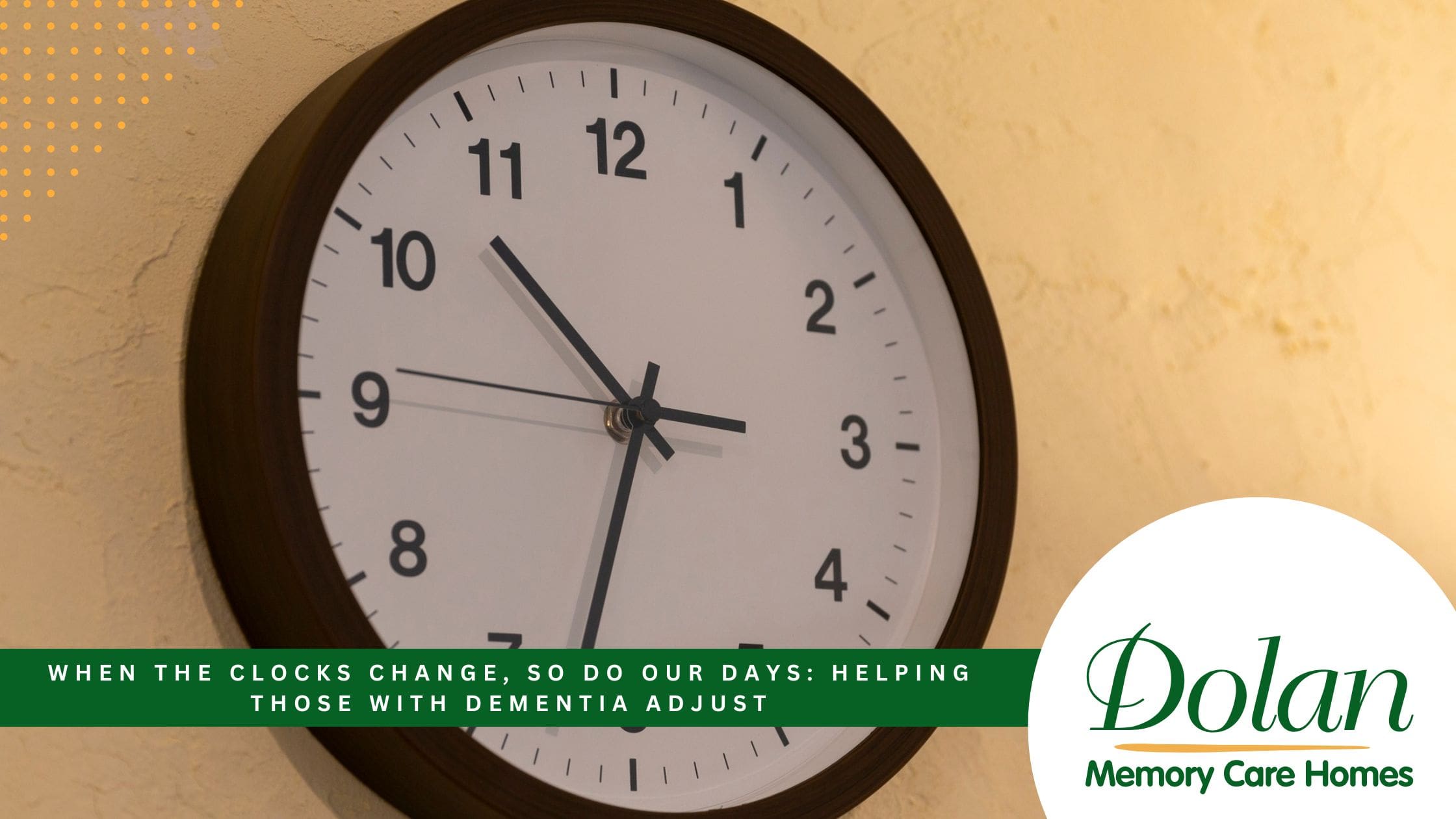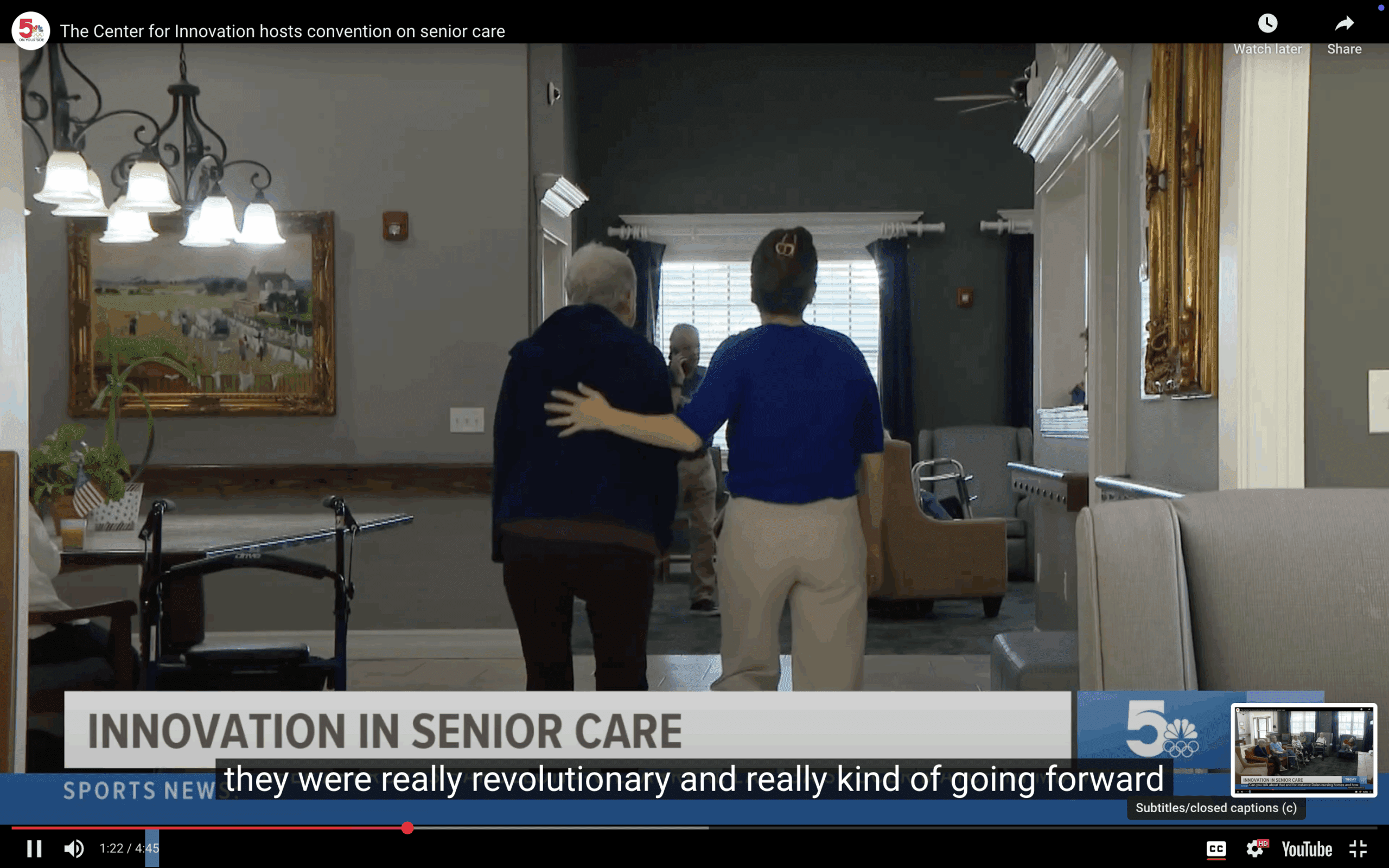Each fall, we all go through the familiar ritual of turning our clocks back one hour. While many people welcome the “extra” hour of sleep, the shift also brings shorter, darker evenings—and for people living with Alzheimer’s or dementia, that change can have a noticeable impact.
At Dolan Memory Care Homes, we’ve supported residents through this seasonal transition for over 30 years. We understand how the change in daylight can disrupt daily rhythms and contribute to a phenomenon known as sundowning. By anticipating these effects, we help residents stay calm, comfortable, and connected to their familiar routines.
Understanding Sundowning
Sundowning describes a pattern of restlessness, confusion, or agitation that often begins in the late afternoon or evening. For those with dementia, the fading light can cause agitation, disorientation, anxiety, restlessness, mood swings, delusions, and an overall decline in cognitive function —especially when routines feel unfamiliar or the environment grows dim.
Researchers believe sundowning stems from changes in the brain that alter the body’s internal clock, or circadian rhythm. Light and darkness impact the circadian rhythm, the internal bodily process that signals and regulated sleep, wakefulness, and mood. When daylight hours suddenly shift—as they do when we “fall back”—it can throw off that natural cycle, leading to greater confusion or irritability.
Why the End of Daylight-Saving Time Matters
In St. Louis, the sun sets at 6:00 p.m. on November 1. After the time change, it sets will set at 4:59 p.m. —and by the end of the month, at 4:39 p.m. That’s a big adjustment for someone who depends on light cues to navigate their day.
For families caring for loved ones at home, these darker afternoons can mean more pacing, sleeplessness, or frustration as evening approaches. At Dolan, we plan ahead for these changes and designed our homes to be bright so that they remain bright, predictable, and comforting during the transition.
How Dolan Memory Care Homes Eases the Transition
Every aspect of our homes—from lighting and meal planning to structured daily routines—is intentionally designed to support individuals living with dementia.
President Tim Dolan explains, “When I designed our homes, I focused on natural light—windows, skylights, and sunrooms—not only to elevate mood but to enhance safety. As people age, changes in vision and balance make falls more likely. While we can’t eliminate every risk, evidence-based dementia home design helps us reduce falls and minimize harm when they do occur.”
Allison Dolan-Boschert, NP-BC, our Geriatric Nurse Consultant, adds, “Late afternoon and early evening have always been busy, transitional times—coming home from work or school, preparing dinner, or wrapping up the day. I’ve observed that many residents still feel that same internal restlessness, as if they should be doing something but aren’t sure what. Providing meaningful activities and gentle direction during this time helps ease that anxiety and bring a sense of calm.”
Here are some of the ways our staff helps residents adapt to the shorter days:
- Bring in the Light
We maximize natural light during the day by encouraging outdoor walks and external activities. We also use the large “sun rooms” for activities to decrease agitation. As the sun begins to set, we gradually brighten indoor spaces to reduce shadows and maintain a warm, inviting atmosphere. Our homes already have “shadow-less” lighting in the hallways, but for people caring for loved ones at home, be aware of increased falls. - Keep Routines Steady
Predictability offers comfort. We maintain consistent schedules for meals, medications, and bedtime, helping residents’ internal clocks stay steady despite the external time shift. - Plan Activities Wisely
Late afternoon is often when confusion increases. We schedule stimulating or social activities earlier in the day and afternoon so that residents do not fall asleep after lunch. This helps prevent the circadian flip – where people sleep all day and are awake all night. We also wind down with soothing music, gentle stretching, or quiet conversation in the evening. - Adjust Meals for the Season
Many seniors sundown so heavier meals in the evening are less likely to be eaten, which can lead to malnutrition and weight loss. Our Executive Chef, Mark DuBro, modifies the fall and winter menu with lighter dinners and heartier lunches—like casseroles with root vegetables—knowing that residents eat more when they are most alert mid-day. This ensures they get the nutrition needed. - Encourage Rest and Relaxation
Evening caffeine, bright screens, and overstimulation can heighten anxiety. We focus on calming rituals, familiar scents, and peaceful environments that promote good sleep. - Offer Reassurance and Companionship
The time change can unsettle even the most resilient residents. Our Care Partners provide calm, steady reassurance and meaningful engagement to help each person feel secure as the day winds down.
Supporting Families at Home
For families caring for loved ones with dementia, these same principles can make a difference. Keep lighting consistent, maintain regular routines, and focus on connection and reassurance. Even small adjustments—like an earlier dinner or an extra afternoon walk—can ease the transition. Most of all, be patient and understanding, as individuals with Alzheimer’s and dementia may become more agitated and disoriented during this time.
Our Commitment to Comfort and Consistency
Daylight saving time can be challenging for all seniors, but especially those with Alzheimer’s and dementia. At Dolan Memory Care Homes, every season brings an opportunity to adapt with compassion. The end of daylight-saving time reminds us that while we can’t control the sun, we can shape an environment that supports peace, predictability, and dignity for those living with dementia.
Bill Vatterott, Director of Marketing





